- Joined
- Aug 18, 2019
- Messages
- 10
A DIY repair to the suspension spring of a vintage / antique wall clock.
Aplogies to the clockmakers if I haven't got names of parts correct
Don't shoot me - I'm only a hobbiest
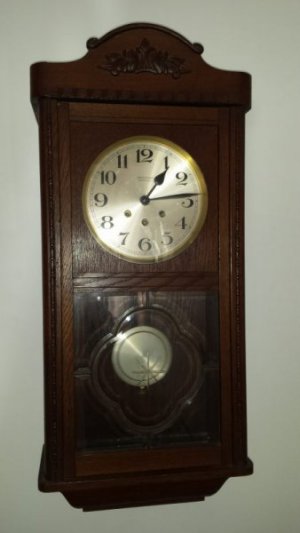
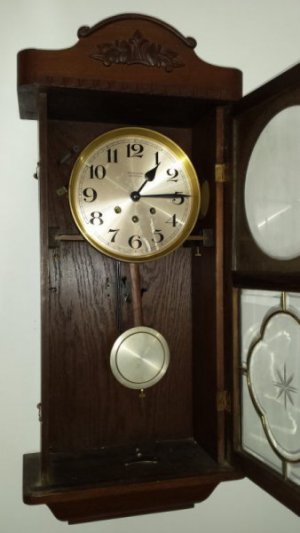
Do you have an old vintage/antique wall clock that is no longer working? Are you like me and want to repair everything that gets broken? Well these old clocks are not that difficult to repair if you take your time and work carefully. These old clocks have quite large parts unlike the minute and intricate parts of a wrist or pocket watch.
Take your time and also take photos from lots of angles to help you not finding spare parts at the end of your repair.
We packed up our home in South Africa and moved to Melbourne in Australia and this old family wall clock was moved without removing the pendulum (that's a no no). The pendulum was tied to the chiming bars at the back of the clock and the movements in the transfer broke the tiny suspension spring.
You NEVER move a pendulum type clock without first removing the pendulum !!
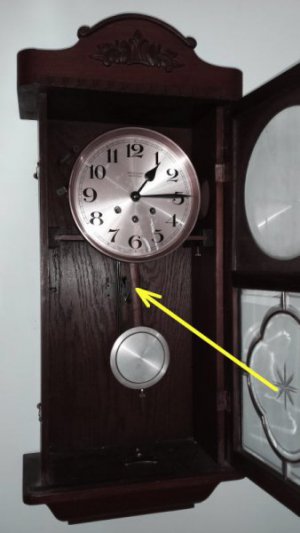
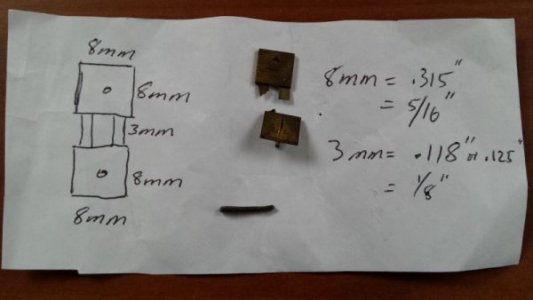
When we found the clock in a broken state I removed the pendulum and checked for all the supporting screws that held the clock in the cabinet. I unscrewed them and carefully pulled the whole clock (face and workings) out. At the back was the upper half remnant of the suspension spring still pinned into it's holder and the lower half remnant of the spring was in the cabinet (as it is not pinned to the first brass section of the pendulum). Unfortunately I did not take pictures of what I was doing at this time. You'll be able to see where these components are from the next images of when I did the final repair.
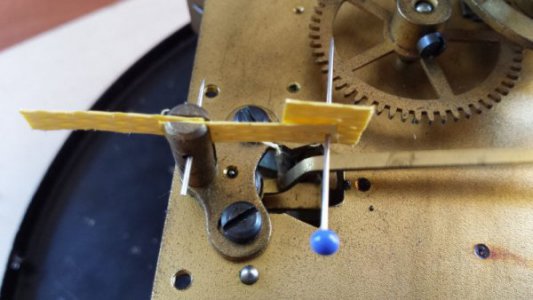
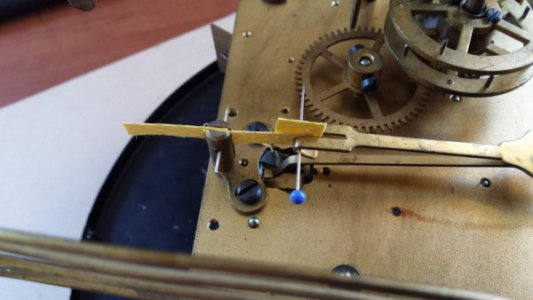
As I'm the Mr Fixit and love it when I can make a plan, I used a little plastic box strapping and a couple of pins to manufacture a makeshift suspension spring. Hey, it might look terrible, and I would hate for a clock maker to see this, but it worked - for a few years. In the meantime I periodically looked around for a real replacement spring.
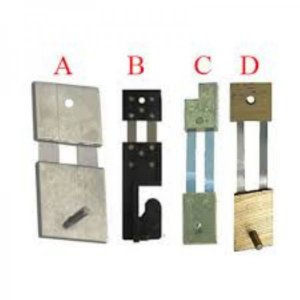
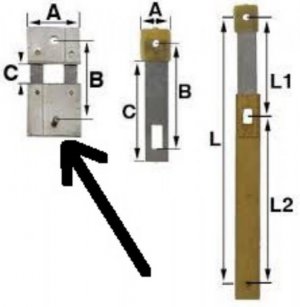
This is what a complete suspension spring might look like. Mine is type A and of the one shown by the arrow.
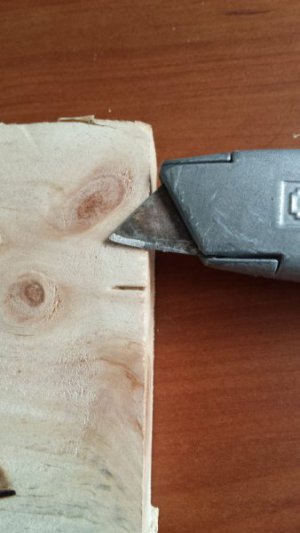
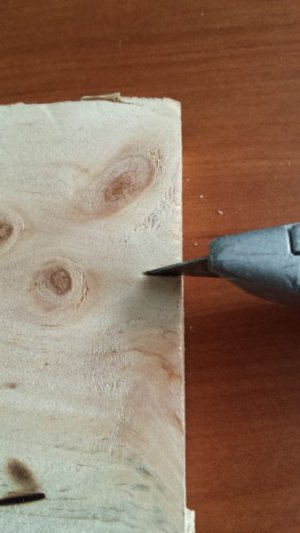
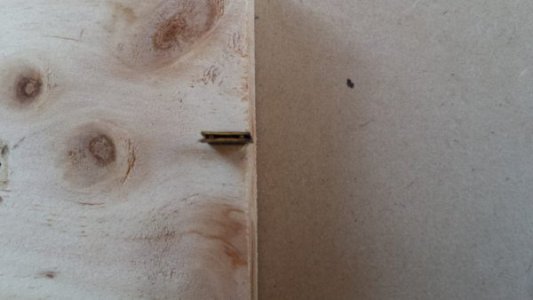
Some few years later I searched eBay for a spring of the same size (I'd measured the plates and steel spring sections - see image above) and could only find one in the USA for about $9, but they wanted $32 for shipping (eeeesh!!) . I contacted a couple of other clock repairing shops and they didn't have this size.
So I decided to see if I could repair this little part. (I have, in the past, tried my hand at some silver and gold jewelry making and enjoy working with small parts). After examining the broken spring with magnification I could see that the little square brass plates were actually 4 plates that were joined and holding the two steel spring plates (now broken). I first wondered if these brass plates had been soldered together and tried to separate them with a gas flame. That didn't work. So next I decided that I would carefully see if the plates would prise open. As you can see from these images I made a little support for the plate by cutting a slot into the edge of a piece of pine timber. with a utility knife. Standing each of the square brass plates upright in this slot I put the utility knife blade along the join and gently tapped the back of it with a hammer - yes - the plates came apart revealing that they were held together by other tiny pins.
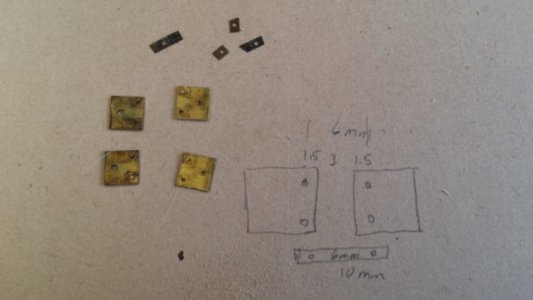
These are all the bits of the broken spring. You can see that the two little steel spring plates are also drilled and are supported by the tiny pins. On of the plates has a large pin through it which you can tap out gently with a small hammer. The other pin is a loose pin that will go back into the top side of the spring and be fixed into the clock. The permanent pin will go back in to hang the pendulum parts on at the end.
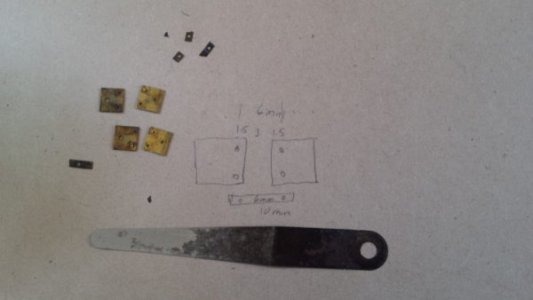
Ok, so now that the plates are separated and the old broken steel springs have been lifted out, where do we get new steel springs or spring material? I measured the thickness of these springs with a micrometer and they are about .04mm (these steel springs are usually .04 or .05mm ).
After a bit of head scratching I remembered that I had an old feeler gauge (used for setting gap spaces in car engines - like distributer points). The smallest of the feeler gauges in the set I have is about .04mm. so this is what I used.
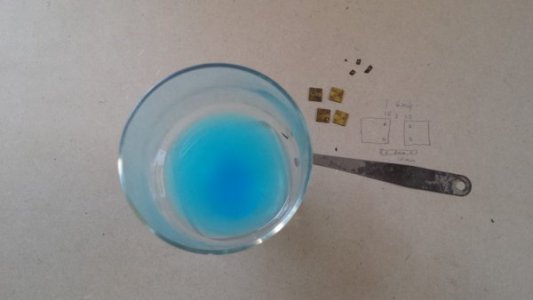
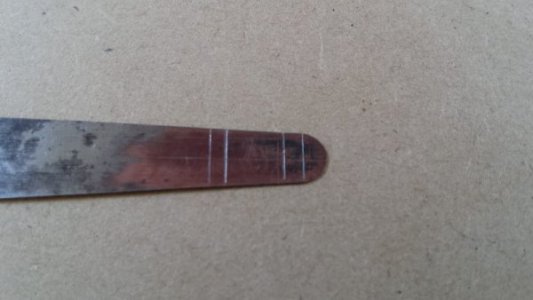
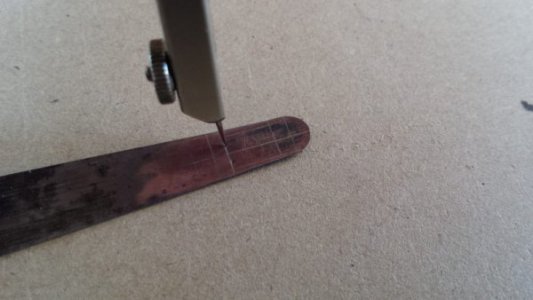
After cleaning up the end of this feeler gauge I made up a solution of copper sulphate (sold at the hardware store or swimming pool supplies). If you have metal marking fluid like "blue" use that. Dip the end of the steel feeler gauge into the solution and the surface is coated with a fine layer of copper. Now you can scribe lines on the surface that are visible. I just used a compass point and a good steel rule with mm markings and set out the cutting lines to make two similar springs.
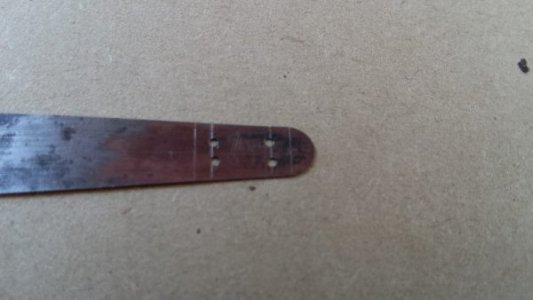
Next I needed to make and drill the 1mm holes that would go back over the tiny pins.
Drill these holes before cutting or you will have great trouble holding these tiny parts. But, being drilled into the full plate I was easily able to drill these 4 holes with my workshop drill press.
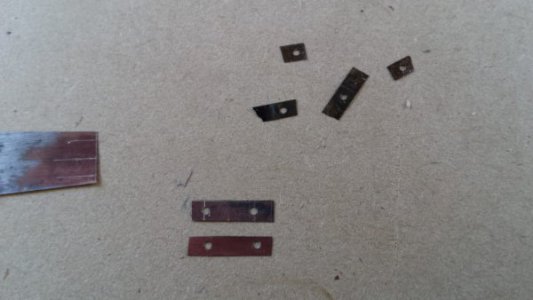
Now carefully cut out the two springs with a pair of scissors. Yes, good scissors will easily cut through this thin steel plate.
Do not use your wife's dressmaking scissors - if you want to carry on living !!! )
)
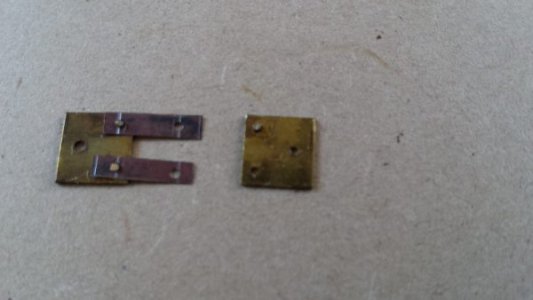
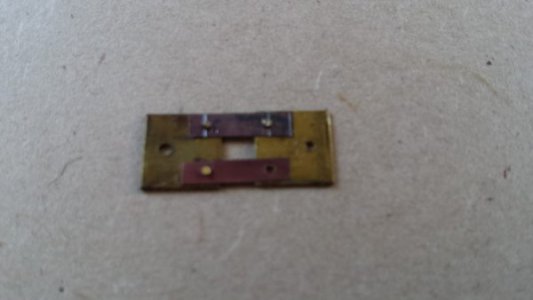
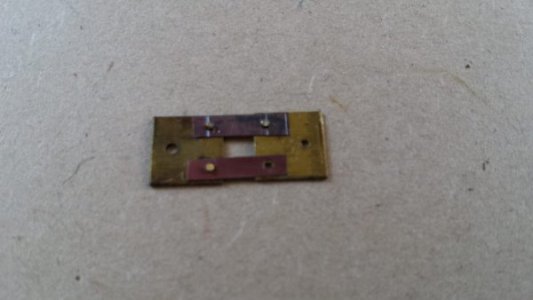
Now it's just a matter of reassembling the parts to the full suspension spring and squeeze the brass plates together with a pair of pliers being very careful to get the little pins lined up into the old holds.
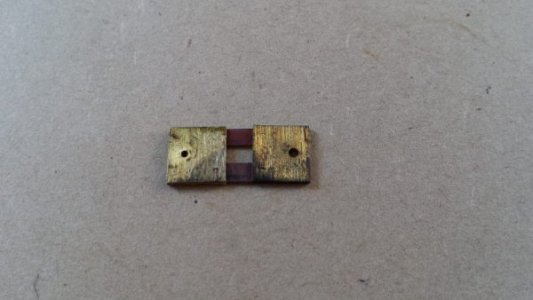
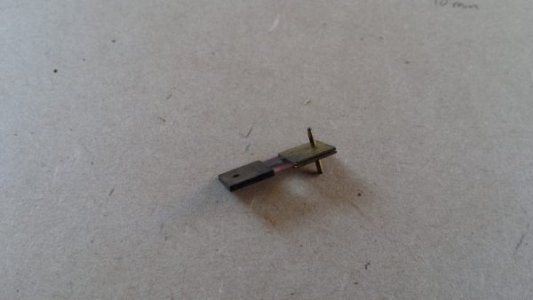
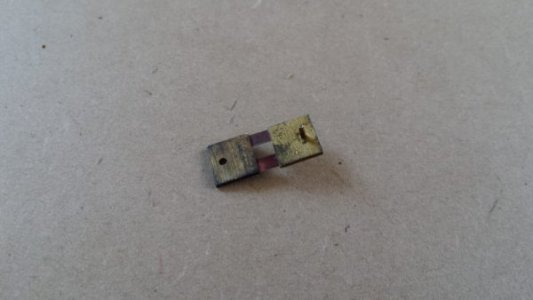
And there is the repaired suspension spring - ready to go back into the clock.
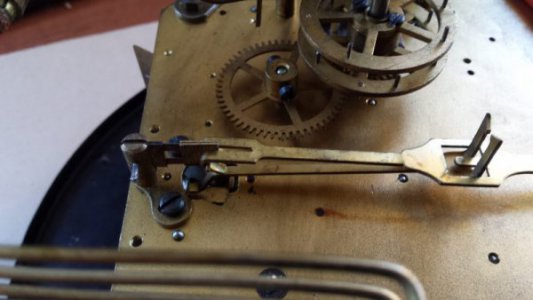
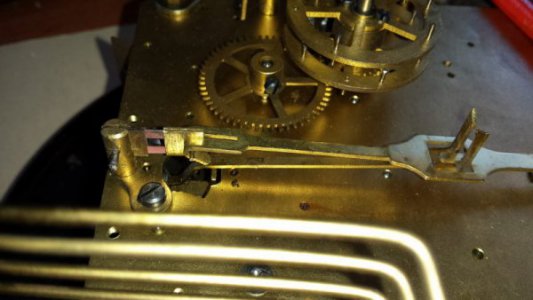
Fit the plate with the loose long pin back into the escapement slot on the clock and press the pin in to hold it in place.
Now hook the first brass part of the pendulum onto the lower (permanent pin) and put the whole clock back into the cabinet.
Secure all the mounting screws etc
Set the cock back up on the wall and CAREFULLY hang the actual pendulum back onto the lower part of the brass pendulum extension.
Your clock will be working again. The clock speed will need to be corrected by adjusting the height of the pendulum weight (the large brass disc in my case) with the thumb screw. Shorten the length of the pendulum for faster and lengthen it for slower. DON"T pull on the pendulum when you do this or you will break the spring again.
Good luck
Aplogies to the clockmakers if I haven't got names of parts correct
Don't shoot me - I'm only a hobbiest


Do you have an old vintage/antique wall clock that is no longer working? Are you like me and want to repair everything that gets broken? Well these old clocks are not that difficult to repair if you take your time and work carefully. These old clocks have quite large parts unlike the minute and intricate parts of a wrist or pocket watch.
Take your time and also take photos from lots of angles to help you not finding spare parts at the end of your repair.
We packed up our home in South Africa and moved to Melbourne in Australia and this old family wall clock was moved without removing the pendulum (that's a no no). The pendulum was tied to the chiming bars at the back of the clock and the movements in the transfer broke the tiny suspension spring.
You NEVER move a pendulum type clock without first removing the pendulum !!


When we found the clock in a broken state I removed the pendulum and checked for all the supporting screws that held the clock in the cabinet. I unscrewed them and carefully pulled the whole clock (face and workings) out. At the back was the upper half remnant of the suspension spring still pinned into it's holder and the lower half remnant of the spring was in the cabinet (as it is not pinned to the first brass section of the pendulum). Unfortunately I did not take pictures of what I was doing at this time. You'll be able to see where these components are from the next images of when I did the final repair.


As I'm the Mr Fixit and love it when I can make a plan, I used a little plastic box strapping and a couple of pins to manufacture a makeshift suspension spring. Hey, it might look terrible, and I would hate for a clock maker to see this, but it worked - for a few years. In the meantime I periodically looked around for a real replacement spring.


This is what a complete suspension spring might look like. Mine is type A and of the one shown by the arrow.



Some few years later I searched eBay for a spring of the same size (I'd measured the plates and steel spring sections - see image above) and could only find one in the USA for about $9, but they wanted $32 for shipping (eeeesh!!) . I contacted a couple of other clock repairing shops and they didn't have this size.
So I decided to see if I could repair this little part. (I have, in the past, tried my hand at some silver and gold jewelry making and enjoy working with small parts). After examining the broken spring with magnification I could see that the little square brass plates were actually 4 plates that were joined and holding the two steel spring plates (now broken). I first wondered if these brass plates had been soldered together and tried to separate them with a gas flame. That didn't work. So next I decided that I would carefully see if the plates would prise open. As you can see from these images I made a little support for the plate by cutting a slot into the edge of a piece of pine timber. with a utility knife. Standing each of the square brass plates upright in this slot I put the utility knife blade along the join and gently tapped the back of it with a hammer - yes - the plates came apart revealing that they were held together by other tiny pins.

These are all the bits of the broken spring. You can see that the two little steel spring plates are also drilled and are supported by the tiny pins. On of the plates has a large pin through it which you can tap out gently with a small hammer. The other pin is a loose pin that will go back into the top side of the spring and be fixed into the clock. The permanent pin will go back in to hang the pendulum parts on at the end.

Ok, so now that the plates are separated and the old broken steel springs have been lifted out, where do we get new steel springs or spring material? I measured the thickness of these springs with a micrometer and they are about .04mm (these steel springs are usually .04 or .05mm ).
After a bit of head scratching I remembered that I had an old feeler gauge (used for setting gap spaces in car engines - like distributer points). The smallest of the feeler gauges in the set I have is about .04mm. so this is what I used.



After cleaning up the end of this feeler gauge I made up a solution of copper sulphate (sold at the hardware store or swimming pool supplies). If you have metal marking fluid like "blue" use that. Dip the end of the steel feeler gauge into the solution and the surface is coated with a fine layer of copper. Now you can scribe lines on the surface that are visible. I just used a compass point and a good steel rule with mm markings and set out the cutting lines to make two similar springs.

Next I needed to make and drill the 1mm holes that would go back over the tiny pins.
Drill these holes before cutting or you will have great trouble holding these tiny parts. But, being drilled into the full plate I was easily able to drill these 4 holes with my workshop drill press.

Now carefully cut out the two springs with a pair of scissors. Yes, good scissors will easily cut through this thin steel plate.
Do not use your wife's dressmaking scissors - if you want to carry on living !!!



Now it's just a matter of reassembling the parts to the full suspension spring and squeeze the brass plates together with a pair of pliers being very careful to get the little pins lined up into the old holds.



And there is the repaired suspension spring - ready to go back into the clock.


Fit the plate with the loose long pin back into the escapement slot on the clock and press the pin in to hold it in place.
Now hook the first brass part of the pendulum onto the lower (permanent pin) and put the whole clock back into the cabinet.
Secure all the mounting screws etc
Set the cock back up on the wall and CAREFULLY hang the actual pendulum back onto the lower part of the brass pendulum extension.
Your clock will be working again. The clock speed will need to be corrected by adjusting the height of the pendulum weight (the large brass disc in my case) with the thumb screw. Shorten the length of the pendulum for faster and lengthen it for slower. DON"T pull on the pendulum when you do this or you will break the spring again.
Good luck

